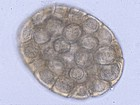Difference between revisions of "Dipylidium caninum"
| (27 intermediate revisions by 4 users not shown) | |||
| Line 1: | Line 1: | ||
| − | {{ | + | {{OpenPagesTop}} |
| − | {{ | + | {{Taxobox |
| − | | | + | |name =''Dipylidium caninum |
| − | | | + | |kingdom =Animalia |
| − | | | + | |phylum =Platyhelminthes |
| − | | | + | |class =[[Cestodes|Cestoda]] |
| − | | | + | |sub-class =[[Cyclophyllidea]] |
| − | | | + | |order = |
| + | |super-family = | ||
| + | |family =Dipylidiidae | ||
| + | |sub-family = | ||
| + | |genus =Dipylidium | ||
| + | |species ='''''D. caninum''''' | ||
}} | }} | ||
| − | + | [[Image:Dipylidium caninum.jpg|thumb|right|150px|''Dipylidium caninum'' - Taenia of Dogs and Cats Joaquim Castellà Veterinary Parasitology Universitat Autònoma de Barcelona]] | |
| + | Also known as: '''''Double-pored tapeworm — Cucumber seed tapeworm | ||
| − | == | + | ==Introduction== |
| − | + | ''D. caninum'' is a very commonly seen parasite of dogs and cats, and of the class [[Cestodes|Cestoda]]. They are capable of growing up to 50cm in length in the small intestine. It is of minor clinical significance, causing no more than occasional anal irritation. Diarrhoea may result if the tapeworms are present in large numbers. The proglottids are motile and can upset owners when they drop onto the furniture or floor. | |
| − | ''D. caninum'' is a very | ||
| + | ==Identification== | ||
| + | ''D. caninum'' resemble ''Taenia spp'', but are considerably shorter than ''Taenia''. ''D. caninum'' have a scolex and a proglottid, which are easily recognized in this species. This parasite also has two sets of genital organs. | ||
| − | + | The eggs are 25-50μm in length. | |
| − | The | ||
| − | |||
| − | |||
| + | ==Life-Cycle== | ||
| + | The '''oncospheres''' are within the egg packets. These are ingested by the intermediate host. They develop into '''cysticercoids''', which is infective by the time that metamorphosis is complete. | ||
| − | + | Complete development in the intermediate hosts lasts around 1 month. The final host is infected via ingestion of the [[Fleas|flea]] or [[Lice|louse]], containing the cysticercoid. | |
| − | + | ||
| + | {{Learning | ||
| + | |literature search = [http://www.cabdirect.org/search.html?q=title%3A%28%22Dipylidium+caninum%22%29 ''Dipylidium caninum'' publications] | ||
| + | |Vetstream = [https://www.vetstream.com/canis/search?s=tapeworm Cestoda] | ||
| + | }} | ||
| + | |||
| + | |||
| + | {{review}} | ||
| + | |||
| + | {{OpenPages}} | ||
| + | |||
| + | [[Category:Cyclophyllidea]] | ||
| + | |||
| + | [[Category:Expert_Review]] | ||
Latest revision as of 17:39, 4 June 2016
| Dipylidium caninum | |
|---|---|
| Kingdom | Animalia |
| Phylum | Platyhelminthes |
| Class | Cestoda |
| Sub-class | Cyclophyllidea |
| Family | Dipylidiidae |
| Genus | Dipylidium |
| Species | D. caninum |
Also known as: Double-pored tapeworm — Cucumber seed tapeworm
Introduction
D. caninum is a very commonly seen parasite of dogs and cats, and of the class Cestoda. They are capable of growing up to 50cm in length in the small intestine. It is of minor clinical significance, causing no more than occasional anal irritation. Diarrhoea may result if the tapeworms are present in large numbers. The proglottids are motile and can upset owners when they drop onto the furniture or floor.
Identification
D. caninum resemble Taenia spp, but are considerably shorter than Taenia. D. caninum have a scolex and a proglottid, which are easily recognized in this species. This parasite also has two sets of genital organs.
The eggs are 25-50μm in length.
Life-Cycle
The oncospheres are within the egg packets. These are ingested by the intermediate host. They develop into cysticercoids, which is infective by the time that metamorphosis is complete.
Complete development in the intermediate hosts lasts around 1 month. The final host is infected via ingestion of the flea or louse, containing the cysticercoid.
| Dipylidium caninum Learning Resources | |
|---|---|
To reach the Vetstream content, please select |
Canis, Felis, Lapis or Equis |
 Search for recent publications via CAB Abstract (CABI log in required) |
Dipylidium caninum publications |
| This article has been peer reviewed but is awaiting expert review. If you would like to help with this, please see more information about expert reviewing. |
Error in widget FBRecommend: unable to write file /var/www/wikivet.net/extensions/Widgets/compiled_templates/wrt663a7f9ddba4b2_16213809 Error in widget google+: unable to write file /var/www/wikivet.net/extensions/Widgets/compiled_templates/wrt663a7f9ddfb931_00286630 Error in widget TwitterTweet: unable to write file /var/www/wikivet.net/extensions/Widgets/compiled_templates/wrt663a7f9de3dbb6_98800533
|
| WikiVet® Introduction - Help WikiVet - Report a Problem |
